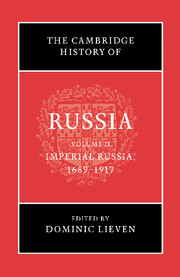Book contents
- Frontmatter
- Introduction
- Part I Empire
- Part II Culture, Ideas, Identities
- Part III Non-Russian Nationalities
- Part IV Russian Society, Law and Economy
- Part V Government
- Part VI Foreign Policy and the Armed Forces
- Part VII Reform, War and Revolution
- 28 The reign of Alexander II: a watershed?
- 29 Russian workers and revolution
- 30 Police and revolutionaries
- 31 War and revolution, 1914–1917
- Bibliography
- Index
- Map 5. The Russian Empire (1913). From Archie Brown, Michael Kaser, and G. S. Smith (eds.) Cambridge Encyclopedia of Russia 1982.">
- Plate Section">
- References
31 - War and revolution, 1914–1917
from Part VII - Reform, War and Revolution
Published online by Cambridge University Press: 28 March 2008
- Frontmatter
- Introduction
- Part I Empire
- Part II Culture, Ideas, Identities
- Part III Non-Russian Nationalities
- Part IV Russian Society, Law and Economy
- Part V Government
- Part VI Foreign Policy and the Armed Forces
- Part VII Reform, War and Revolution
- 28 The reign of Alexander II: a watershed?
- 29 Russian workers and revolution
- 30 Police and revolutionaries
- 31 War and revolution, 1914–1917
- Bibliography
- Index
- Map 5. The Russian Empire (1913). From Archie Brown, Michael Kaser, and G. S. Smith (eds.) Cambridge Encyclopedia of Russia 1982.">
- Plate Section">
- References
Summary
With the abdication of Tsar Nicholas II on 2 March 1917 in favour of the Grand Duke Michael and the latter’s subsequent refusal of the crown, the Romanov dynasty came to an end. The struggle for power and for the definition of the new regime continued through more than four years of revolutionary turmoil and civil war. This chapter outlines Russia’s involvement in the First World War, concentrating on the specific ways in which it caused the end of the old regime.
Any attempt to attribute causes must begin with a definition of the event to be explained. When describing ‘the end of the old regime’, historians are often primarily concerned with the social and national transformations of the revolutionary era that brought the end of the old social order. This chapter focuses on explaining the more specific political end point of regime change when the tsar abdicated and representatives of the national parliament (the Duma), in consultation with representatives of worker and soldier councils, formed a new provisional government. This event marked the end of the Romanov dynasty, the end of Imperial Russia, and the beginning of the social and national revolutions which swept the land through the rest of 1917 and beyond.
The proximate causes of February 1917
The immediate events leading to the abdication began with the confluence of several factors to bring large numbers of people into the Petrograd streets. First, heavy snows in early February 1917 slowed trains, exacerbating chronic wartime problems with flour supply to the cities. Many bakeries temporarily closed due to shortages of flour or fuel.
Keywords
- Type
- Chapter
- Information
- The Cambridge History of Russia , pp. 655 - 669Publisher: Cambridge University PressPrint publication year: 2006
References
- 5
- Cited by



